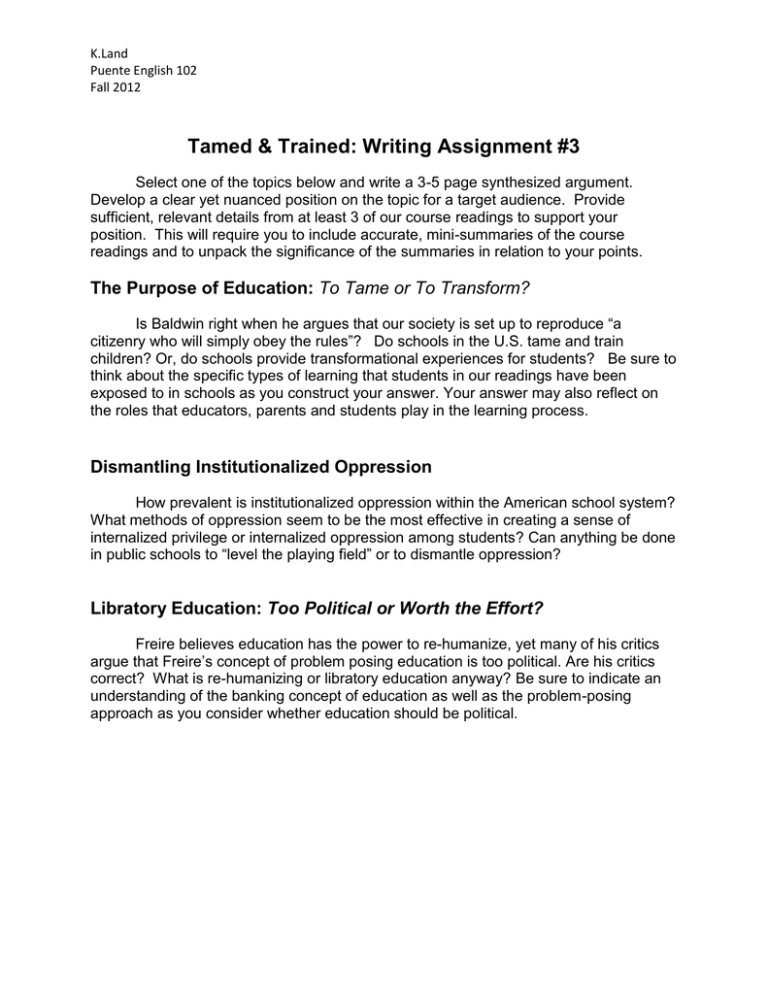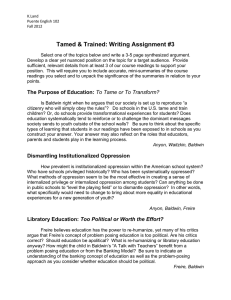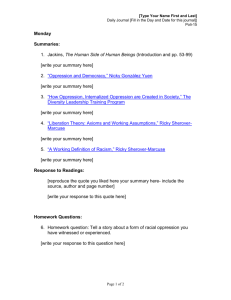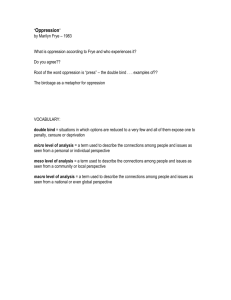Tamed & Trained: Writing Assignment #3
advertisement

K.Land Puente English 102 Fall 2012 Tamed & Trained: Writing Assignment #3 Select one of the topics below and write a 3-5 page synthesized argument. Develop a clear yet nuanced position on the topic for a target audience. Provide sufficient, relevant details from at least 3 of our course readings to support your position. This will require you to include accurate, mini-summaries of the course readings and to unpack the significance of the summaries in relation to your points. The Purpose of Education: To Tame or To Transform? Is Baldwin right when he argues that our society is set up to reproduce “a citizenry who will simply obey the rules”? Do schools in the U.S. tame and train children? Or, do schools provide transformational experiences for students? Be sure to think about the specific types of learning that students in our readings have been exposed to in schools as you construct your answer. Your answer may also reflect on the roles that educators, parents and students play in the learning process. Dismantling Institutionalized Oppression How prevalent is institutionalized oppression within the American school system? What methods of oppression seem to be the most effective in creating a sense of internalized privilege or internalized oppression among students? Can anything be done in public schools to “level the playing field” or to dismantle oppression? Libratory Education: Too Political or Worth the Effort? Freire believes education has the power to re-humanize, yet many of his critics argue that Freire’s concept of problem posing education is too political. Are his critics correct? What is re-humanizing or libratory education anyway? Be sure to indicate an understanding of the banking concept of education as well as the problem-posing approach as you consider whether education should be political. K.Land Puente English 102 Fall 2012 Genre Requirements Attend to your audience’s concerns and your purpose as you organize your paper. This may include finding spots to define terms or to answer burning questions your reader may have. It may also include adding and responding to an opposing perspective. Craft an introduction that enters the conversation with a hook and some background. Starting with a summary to enter the conversation is one option to “hook” the reader. You may summarize an opponent’s perspective, a class reading, or a standard belief. State your own position clearly toward the beginning of your paper, usually at the end of your introduction. This is your thesis. A strong title may also alert the reader to your thesis. Clear points should provide focus for most, if not all, body paragraphs and be organized so that your argument builds. Support each point with sufficient, relevant evidence drawn from our class readings. You may also integrate personal experiences/observations as long as you also have a significant amount of course readings integrated into the paper. a. Use the quote sandwich for all direct quotations. b. Document the works that you cite inside of the text using MLA format c. Document paraphrases AND direct quotations. MLA Format – 12 point, Times New Roman font, double spaced Related Course Readings (Select 3) A Place to Stand by Jimmy Santiago Baca “A Talk with Teachers” by James Baldwin “Banking Concept of Education” from Pedagogy of the Oppressed by Paulo Freire “Social Class & the Hidden Curriculum of Work” by Jean Anyon “Two Approaches to Learning” by Josh Waitzkin “In Lak Ech: Notes on Dehumanization and Rehumanization” by Mario Chacon “How to Tame a Wild Tongue” by Gloria Anzaldua “Attention Shoppers” by Michelle Serros







